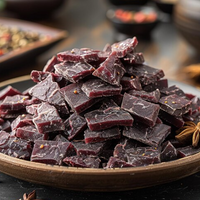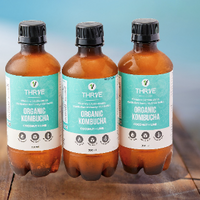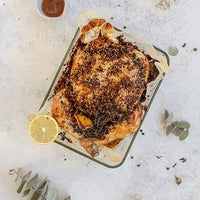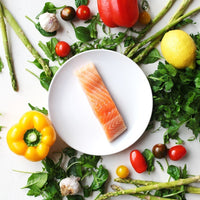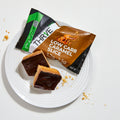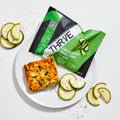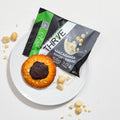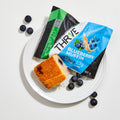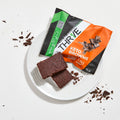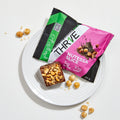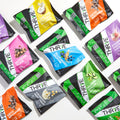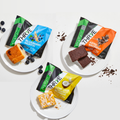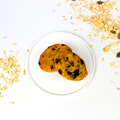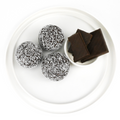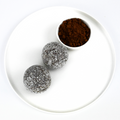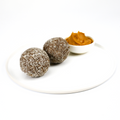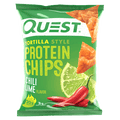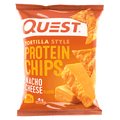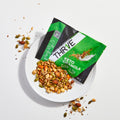Australia loves the sweet stuff. It’s not surprising, considering even “healthy” food can have sugar lurking in the ingredients list. There’s a few simple tips and tricks that can help you slay your sweet tooth – without making too many sacrifices.
 According to the Australian Bureau of Statistics, the average Aussie consumes 25 teaspoons of sugar every day – more than half of which are “free sugars”. You’ll find these refined sugars added to packaged foods and drinks. “They’re typically found as sucrose, which is the combination of glucose and fructose,” says THR1VE nutritionist Shannon Young. “By contrast, natural sugars are found in fruit as fructose and in dairy products as lactose.”
According to the Australian Bureau of Statistics, the average Aussie consumes 25 teaspoons of sugar every day – more than half of which are “free sugars”. You’ll find these refined sugars added to packaged foods and drinks. “They’re typically found as sucrose, which is the combination of glucose and fructose,” says THR1VE nutritionist Shannon Young. “By contrast, natural sugars are found in fruit as fructose and in dairy products as lactose.”
The body metabolises these two types of sugar slightly differently. “The body breaks down refined sugar rapidly, causing insulin and blood sugar levels to spike – the fibre in fruit and fat in dairy products slows down metabolism, increasing satiety slightly,” Young explains. “However, once the sugar passes through the stomach and reaches the small intestine, it doesn’t matter if it came from an apple or a soft drink – at the end of the day sugar is used either for energy or converted and stored as fat.”
Fat doesn’t make you fat
For years we’ve been told to eat low-fat for optimal health, despite evidence to suggest sugar is the real culprit. In fact, a recent report in the journal PLOS Biology found that as far back as the 60s, the sugar industry funded research that suggested sugar may increase the risk of coronary heart disease and bladder cancer. Unsurprisingly, they did not publish the results.
The World Health Organisation recommends we cut down sugar to around five per cent of our total daily calorie intake, which equates to about 25g or six teaspoons per day. Young agrees: “We should cut down on our overall intake, but there is room for a small amount of sugar coming from fruit, sweeter vegetables and unsweetened milk which have vitamins and minerals. However, regular consumption of sugar produces a constant release of insulin and this can lead to problems such as insulin resistance, obesity, type II diabetes, an increase in ‘bad’ cholesterol and the accumulation of fat on all tissues – all the things we were told were caused by fat!”
Where is sugar hiding?
Sure, we know that we should cut back on chocolate, pastries, cakes and foods of that ilk. But the statistics show they are only one part of the problem. So where else are they hiding?
“Lots of products marketed as ‘healthy’ normally have a lot unnecessary sugars added to them. Low-fat foods are usually the worst offenders, as manufacturers use sugar to add flavour,” says Young. “It’s important to learn to read labels and nutritional panels to really see what you are consuming. Nutritional labels are required by law to list their most prominent ingredients first, however companies have mastered hiding sugar in the list so you don’t notice them. This means by putting two or three different types of sugar in the product (and calling them each a different name), they can spread out the sugar across multiple ingredients – without you even noticing.”
Here’s a few other ‘healthy’ places sugars are hiding…
Your green juice
The biggest culprit is liquid sugars. We’re consuming an average of 2310 teaspoons of sugar from drinks alone every year. That’s 9.7 kilos of sugar! Most of this comes from soft drinks and flavoured drinks, but the next biggest offender is actually fruit and vegetable juices.
“These can contain high amounts of sugar. Most of the fibre has been removed so these products can have a similar effect on our bodies as processed sugars. They’re broken down rapidly, causing insulin and blood sugar levels to spike,” Young says. “While they can contain lots of essential vitamins and minerals, it’s always better to consume fruit and vegetables in their natural form.” While a green juice certainly trumps a sugary soft drink, still be cautious. If you are sipping on them, look for one with more veggies than fruit.
Your expensive organic yoghurt
Young calls these out as one of the biggest offenders. We’re now consuming over 60% more sugar from yoghurt, compared to what we did in the 90s. A quick scan of the supermarket shelves reveals that a popular organic blueberry yoghurt has 20g of sugar per small, 170g tub. That’s five teaspoons of sugar! Sure, the added sugar is raw and organic… but it’s still sugar. Another gourmet brand’s mango yoghurt has a whopping 28.1g of sugar, per 160g serving – that’s seven teaspoons of sugar a serve, or more than your entire daily intake in one tiny tub. Instead, try a no added sugar, full fat yoghurt – a popular brand has only 4.1g of sugar, all of which are natural sugars from milk.
Your health star-approved wholegrain cereal
Cereals are a popular hiding spot for sugar. Even the health stars that have popped up on the packs can be misleading. A popular brand of ‘healthy’ cereal that has four health stars lists sugar as its second major ingredient, plus there’s more sugar in the “supplementary base” and glucose (another name for sugar) listed separately on the ingredients list. It has 10g of sugar per small half cup serving, which you would eat with at least half a cup of milk – taking the bowl to 17.9g of sugar. That’s already over half of your daily intake in one small bowl.
Plus, our intake of cereal is often naturally more than the small 30-45g recommended serving size – making it easy to double or triple your sugar intake in one sitting. Top it with some yoghurt and it’s easy to see how your sugar intake may accidentally blow out, despite the best intentions. If you’re a cereal fan, stick to a low sugar, portion controlled variety or wholegrains with no added sugar. Try serving with unsweetened almond milk to slash the sugars further.
Healthy ready meals
Sure, we’re a bit biased here at THR1VE, but so many allegedly “healthy” ready meals have refined sugars peppered through their ingredient lists – along with a whole heap of extra nasties. If you check the packets of our ready meals, you’ll never find refined sugars. Just sayin’… Check them out here.

Ready to make the cut?
“Stick with it,” advises Young. “We become accustomed to these sweet foods so when we do consume foods without hidden sugars we find them bland or boring. However, it doesn’t take long for our taste buds to adjust and start to really taste the natural flavours of whole fresh food. While you make the transition, opt for the natural sugars that have the added health benefits, such as good quality honey or maple syrup.” Sweet as.

